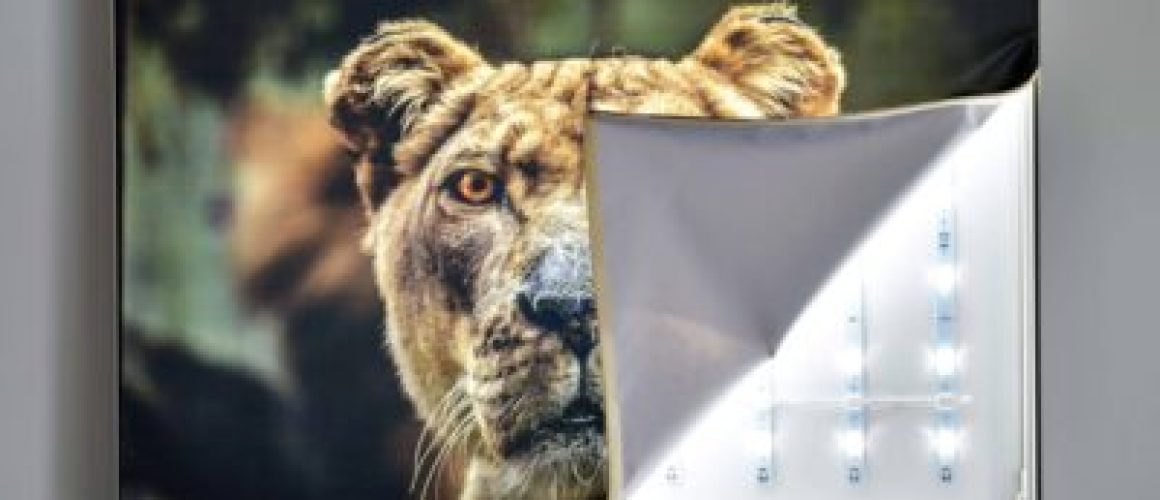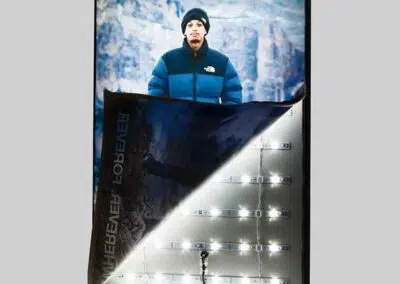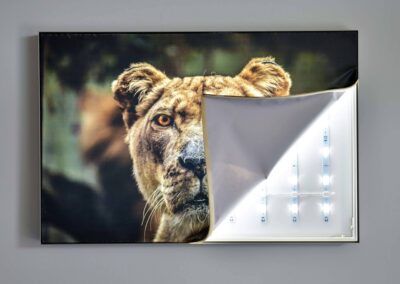Backlit fabric printing different choices
Backlit fabric printing offers several benefits.Making it a popular choice for a variety of applications. Here are some of the key advantages:
Characteristics
- Vivid and Vibrant Graphics: Backlit fabric printing allows for high-resolution and vibrant graphics to be displayed on the fabric. The use of dye-sublimation or direct-to-fabric printing processes ensures that colors are vivid and images are sharp. This creates eye-catching visuals that stand out.
- Even Lighting Distribution: Backlit fabrics are designed to be used with backlighting. Such as LED lights. The fabric’s unique properties allow for even distribution of light across the entire surface. Preventing hotspots and ensuring a consistent and visually appealing glow.
- Durability and Longevity: Backlit fabrics are typically made from durable materials that are resistant to fading, stretching, and tearing. This makes them suitable for long-term use in various indoor and even some outdoor settings. Additionally, the fabric can often be machine washed without compromising the print quality.
- Lightweight and Portable: Backlit fabric materials are lightweight and easy to transport. Making them ideal for trade shows, events, and exhibitions. They can be folded or rolled up for convenient storage and transportation, saving on shipping and storage costs.
- Versatility in Applications: Backlit fabric printing can be used for a wide range of applications. Including trade show displays, retail signage, event backdrops, indoor banners, lightboxes, architectural installations, and more. Its versatility makes it suitable for both commercial and artistic purposes.
- Energy Efficiency: Backlit fabrics are designed to work with LED lights, which are energy-efficient and have a longer lifespan compared to traditional lighting options. This combination of backlit fabric and LED lighting can lead to reduced energy consumption and lower operating costs.
- Easy Installation: Installing backlit fabric graphics is often straightforward and can be done without the need for specialized tools or expertise. The fabric can be attached to frames, tension systems, or lightboxes using various methods such as silicone edge graphics. (SEG). This insures a seamless and polished look.
- Customization and Personalization: Backlit fabric printing allows for customization and personalization of graphics. Businesses can showcase their branding, products, and messages in a visually appealing and unique way. Helping them stand out from the competition.
- Reduced Glare and Reflection: Backlit fabrics are designed to diffuse light. Which helps to reduce glare and minimize unwanted reflections. This is especially important in environments where direct lighting could be problematic. Such as retail spaces or photography studios.
- Environmentally Friendly: Many backlit fabric materials are made from eco-friendly and recyclable materials. This makes them a more sustainable option compared to certain other printing substrates. Additionally, the use of energy-efficient LED lighting aligns with environmental conservation efforts.
Overall, backlit fabric printing offers a combination of striking visuals, durability, versatility, and environmental considerations. Making it an attractive choice for a wide range of applications across various industries
Side lit versus backlit
Side-lit and backlit fabric refer to different methods of lighting textiles or materials to achieve specific visual effects. The primary distinction between them lies in the direction of the light source. In relation to the fabric and the resulting visual impact they create.
Side-lit Fabric: Side lighting involves placing the light source to the side of the fabric. The light falls across the surface of the material. This can result in a more even illumination and can highlight the texture, patterns, and details of the fabric. Side-lit fabric can create a sense of depth and three-dimensionality.Making it a popular choice for displays, art installations, and photography where the surface details of the fabric are crucial. Side lit also need a thicker frame profile for proper light disbursment
Advantages:
- Highlights texture and details.
- Creates a sense of depth and dimension.
- Provides even illumination.
Disadvantages:
- Shadows can still occur on the opposite side of the light source.
- Needs a thicker frame
Backlit Fabric: Backlighting is a technique where the light source is positioned behind the fabric, allowing it to shine through. This creates a visually stunning effect, making the fabric appear to glow or become translucent. Backlit fabric is widely used in signage, displays, and architectural elements. Which establishes a vibrant and captivating visual impact. This effect is especially captivating when the fabric boasts intricate patterns. Or aims to achieve a radiant and ethereal appearance.
Advantagies :
- Can make intricate patterns and colors pop.
- Offers a unique and attention-grabbing look.
Disadvantages:
- More costly then side- lit
- Needs to be shipped in one piece
Summary
In summary, side-lit fabric accentuates texture, depth, and surface details, while backlit fabric produces a captivating, luminous effect that is visually stunning. The selection between side lighting and backlighting relies on the desired aesthetic and specific application. Be it for photography, displays, art installations, or other visual projects.
Is it expensive ?
The cost of backlit fabric printing can vary based on several factors. Including the size of the print, the type of fabric and printing technology used, the complexity of the design, and the quantity of prints ordered. Here are some factors that can influence the cost:
- Print Size: Larger prints will generally cost more than smaller ones due to the increased material and printing time required.
- Type of Fabric: Different types of backlit fabric materials are available, ranging from standard polyester fabrics to premium options. The choice of fabric can impact the cost.
- Printing Technology: The printing method used, such as dye-sublimation or direct-to-fabric printing, can affect the cost. Dye-sublimation printing, which provides vibrant and long-lasting colors, may be more expensive but offers higher quality results.
- Design Complexity: Intricate and detailed designs may require more time and resources to print, potentially affecting the overall cost.
- Quantity: Ordering larger quantities of prints may result in volume discounts, reducing the cost per unit.
- Finishing Options: Additional finishing options like hemming, grommets, or silicone edge graphics (SEG) for framing can add to the overall cost.
- Backlighting System: While the cost of fabric printing is one aspect to see. You’ll also need to consider the cost of the backlighting system (such as LED lights) that complements the backlit fabric. This can vary based on the type and size of the lighting used.
- Shipping and Installation: Shipping costs and any installation expenses should be factored in as well.
- If its side or back lit– Side lit backlighting is a very economical option that provides cost-effective illumination. However, it may have some light gaps that could affect overall uniformity. On the other hand, backlit lighting offers a more consistent and uniform illumination. Making it an upscale choice for those who prioritize optimal lighting quality. At big acrylic we use a 2 inch frame and backlit style. As below shows
Conclusion
It’s important to note that while backlit fabric printing may have an initial cost. However its durability, versatility, and impact can make it a cost-effective choice . Especially when compared to other temporary signage options.
To get an accurate cost estimate for your specific project, it’s recommended to reach out to printing companies or suppliers that specialize in backlit fabric printing. They can provide you with quotes based on your unique requirements and specifications.






